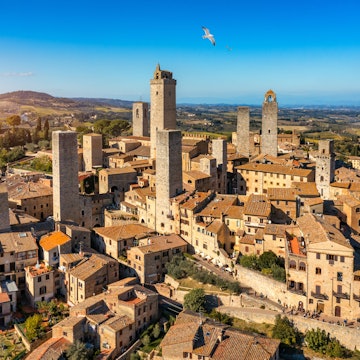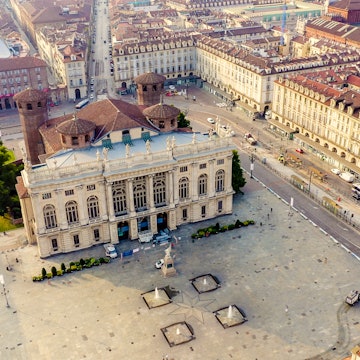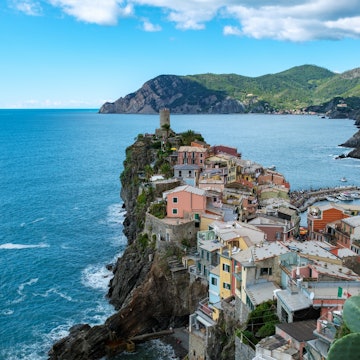

Tuscany is a year-round destination, but it's worth planning around the weather – here are the best times to visit. Shutterstock
Tuscany is the Italy many people dream about. Expanses of rolling countryside where life proceeds deliciously slowly. Perfectly symmetrical vineyards where some of the world’s best wines are cultivated. Grand, Renaissance-era cities and medieval hamlets with traditional restaurants that beckon you with the smell of roasted meats.
Situated in the center of Italy, Tuscany benefits from a mild climate, making it a great destination year-round, although the countryside is best enjoyed when the weather is favorable. Activities that were once reserved for summer, such as hiking, cycling, and even city strolling, are now best carried out in spring or early fall due to rising summer temperatures.
When it’s above 30°C (86°F), you don’t want to be out under the scorching sun, unless you're at the beach where you can take refuge in the water. But all of Tuscany's seasons have their pros and cons – here's our guide to the best times to come.

Spring is the best season to enjoy Tuscany without the crowds
If your goal is to spend time outdoors, spring is generally the best and possibly the most underrated time to visit Tuscany. Winter wind and rain give way to more forgiving weather that doesn’t yet yield to the scorching sun you'll encounter in summer.
The months of April, May and June are ideal for enjoying the Tuscan slow tourism experience. You can walk or cycle along the Via Francigena, passing through historic towns such as San Miniato and San Quirico d’Orcia and immersing yourself in landscapes that are still green before the summer heat builds.
This is a prime time to sample spring produce that includes fresh asparagus and truffles (tartufo marzuolo). Towards the end of the season, temperatures will have warmed enough to justify a visit to the coast around Orbetello, Cala Violina and Marina di Bibbona, as Italy's many privately run beaches reopen, usually just after Easter.

See Florence in a different light from December to January
Firenze (Florence), the capital of Tuscany, is known to the world as the cradle of the Renaissance, and this historic city has an abundance of unique sights and museums in its historic center. Visiting off-season is a must, however, unless you want to spend your precious vacation time waiting in line. December and January can be busy over the Christmas period and during the first week of the new year, but are otherwise crowd-free.
What’s more, Florence is decorated for the holidays at this time of year, so everything sparkles a little bit brighter. In addition to Nativity scenes, Christmas trees and holiday decorations across the city, Florence celebrates Green Line Firenze, a festival of lights projecting digital art onto the city’s historical buildings every evening from 5:30pm to 10pm.
Are there cons to visiting in December or January? Well, it rains quite a bit, but there's an easy solution. Before you arrive, make a bucket list of things you want to do in
Florence, and keep your schedule flexible so you can change plans as the weather changes. Allow a day in your schedule to visit the Galleria degli Uffizi,
and save this for a particularly rainy day rather than a sunny
one.
If you're visiting at Christmas, enjoy activities away from the tourist trail, including a visit to Museo Stibbert to browse the collection of antiques and armor, or enjoy a winter walk at Giardino Bardini. The city's largest Christmas market – a pop-up northern European village made up of wooden cottages where you can buy anything from handmade trinkets to local cheeses and wines – opens in Piazza Santa Croce from November 18.

July and August are the top months to experience Siena
Usually, I tell people to avoid traveling to Tuscany (and Italy in general) in July and August for obvious reasons. Tourism reaches its peak, and so does the temperature. What's more, August is the month when Italians go on vacation, increasing the number of tourists “visiting” Italy by several million.
But if you’re a culture buff, it's worth making an exception for Siena. In July and August, the mosaic pavement at Siena Cathedral – laid between the 14th and 16th centuries and normally hidden to protect it from trampling visitors – is uncovered. Tickets to view the mosaics cost €8, and opening dates vary from one year to the next, so it’s best to check the schedule on the Duomo’s official website.
Then, of course, there’s the Palio, held on July 2 and August 16 every year. This isn’t your average horse race – it’s a centuries-old competition between Siena’s 17 contrade (districts), packed with fierce tradition and long-standing rivalries. You can watch it for free from the center of Piazza del Campo if you’re willing to stake out a spot early, or pay top dollar for a prime view from one of the surrounding balconies.
Either way, it’s an unforgettable spectacle, full of history and passion. If you're traveling with children, prioritize the parade that precedes the horse race, where 700 senesi (Siena citizens) dress up in traditional costumes.

Wine lovers should visit Tuscany in September and October
September and October are the peak months for the grape harvest in Tuscany – known here as vendemmia – and the region’s vineyards are at their liveliest. This isn’t just about wine production; it’s a celebration of rural communities, cultural traditions, and, of course, some of the finest wines in the world.
During the harvest months, many wineries open their doors to visitors, offering hands-on experiences such as tastings, grape-picking and learning about wine-making techniques. Tuscany’s Cantine Aperte and Vigneti Aperti events are your golden ticket to vineyard tours, tastings and cultural programs that celebrate all things vino. The weather is mild, the crowds have thinned out, and the landscape is awash with autumn colors – it’s a beautiful time to explore both the region and its wines.
If you’d like to visit the vineyards without having to worry about organizing things yourself, consider joining a tour with The Tuscany Experience to see how Brunello di Montalcino, Sassicaia, Solaia and Tignanello wines are made. If you want to become a winemaker for a day, you can assist master vintner Roberto Cipresso as he teaches you about the mysteries of Brunello di Montalcino. Or, if you’re looking for a simpler activity, visit Carpineto’s Tenuta di Montepulciano and enjoy tastings and walks in their charming, zero-emissions estate.
Autumn is also the season for Tuscany's famed Tartufo Bianco truffles. As well as enjoying truffle-sprinkled menus, you can dive in and go truffle hunting in various corners of Tuscany, or book in-depth truffle experiences led by expert truffle hunters.
















